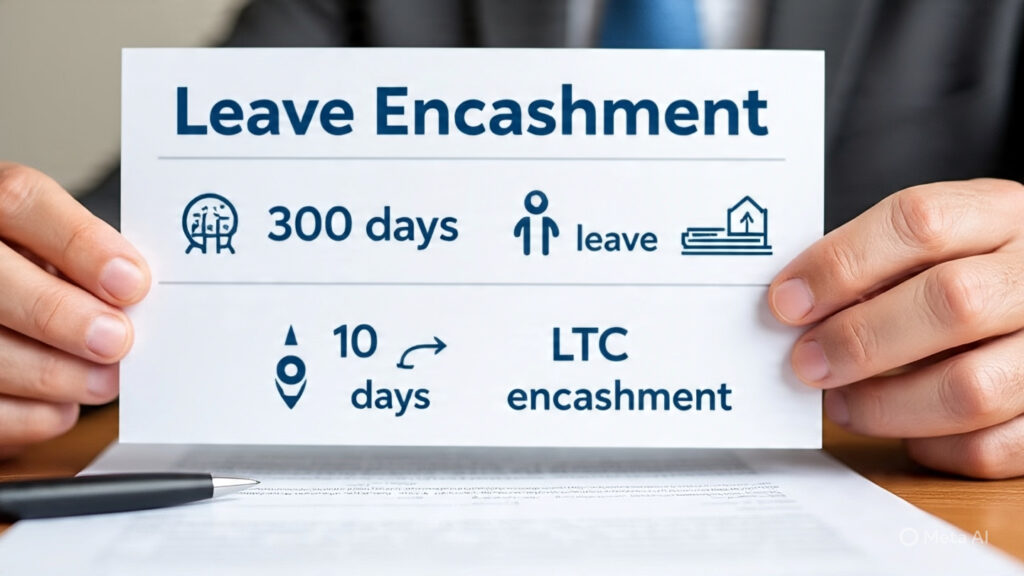
Contents
- 1 Leave Encashment: Rules, Exemptions, and Formula Explained
- 2 What is Leave Encashment?
- 3 Types of Leave balance encashment
- 4 Leave Encashment Rules in India
- 5 Leave balance encashment Exemption Under Income Tax
- 6 Leave Encashment Formula
- 7 Common Myths About Leave balance encashment
- 8 Frequently Asked Questions (FAQs)
- 9 Conclusion: Is Leave Encashment Beneficial for Employees?
Leave Encashment: Rules, Exemptions, and Formula Explained
Leave encashment is great opportunity to monentize unused or extra leave. There are many provision availabe for both central and private employee to encash their leave.
What is Leave Encashment?
Leave encashment is the process of receiving money in exchange for unused paid leave. Instead of losing those leaves, the employer compensates you financially.
Why Do Companies / Govt Offer Leave Encashment?
- To reward employees for their commitment
- To provide financial support at retirement
To ensure fairness—unused leaves don’t go wasted
Types of Leave balance encashment
During Service
Employees may encash unused leaves at certain intervals as per company policy. However, the amount received during service is generally fully taxable for pvt employee.
At the Time of Retirement or Resignation
This is the most common form. Employees receive payment for accumulated leaves when leaving the company. The tax treatment differs for government and private employees.
Leave Encashment Rules in India
Leave balance encashment is guided by both company HR policies and the Income Tax Act, Section 10(10AA). However, the rules differ for government and private sector employees.
Applicability to Government Employees
Government employees enjoy more favorable rules when it comes to Leave balance encashment
- At Retirement: They can encash up to 300 days of earned leave and half pay leave together. The entire amount received is fully tax-exempt.
- During Service (LTC – Leave Travel Concession): Employees can encash 10 days of earned leave in one block while availing LTC. The overall maximum encashment allowed during service is 60 days.
This ensures that government employees benefit both during their service and at the time of retirement.
Applicability to Private Sector Employees
- For private sector employees, leave encashment received during service is fully taxabl
- At retirement or resignation, they get partial exemption under Section 10(10AA), subject to the ₹3,00,000 limit.
Leave balance encashment Exemption Under Income Tax
The amount exempt depends on whether the employee works in the government sector or private sector.
Tax Treatment for Government Employees
- 100% exemption on leave encashment received at retirement
- No tax liability on the amount received
Tax Treatment for Non-Government Employees
The exemption is the least of the following four amounts:
- Actual leave encashment received
- 10 months’ average salary
- Cash equivalent of earned leave (not exceeding 30 days per year of service)
- ₹3,00,000 (statutory limit)
Section 10(10AA) Provisions
Section 10(10AA) of the Income Tax Act provides detailed rules for calculating exemption. It ensures fair tax treatment depending on the employee’s sector and salary.
Leave Encashment Formula
The leave encashment calculation depends on the employee’s last drawn salary and the number of unused leaves.
How to Calculate Leave Encashment During Service
Leave Encashment = (Basic Salary + Dearness Allowance) ÷ 30 × No. of Leaves
Example Calculation
Suppose an employee retires with the following details:
- Last drawn salary (Basic + DA): ₹50,000 per month
- leaves Balance: 240 days
- Service period: 20 years
- Leave allowed per year: 30 days
Cash equivalent of earned leave = (20 years × 30 days) – 240 days used = 360 days
= (50,000 ÷ 30) × 240 = ₹4,00,000
Now apply exemption rules. If ₹3,00,000 is the minimum of the four conditions, then:
- Exempt amount = ₹3,00,000
Taxable amount = ₹1,00,000
Common Myths About Leave balance encashment
Myth 1: All leave encashment is tax-free.
✅ Reality: Only government employees get full exemption. Private employees get partial exemption.
Myth 2: Exemption applies every time you encash.
✅ Reality: For non-government employees, the ₹3,00,000 exemption is a lifetime limit.
Frequently Asked Questions (FAQs)
Q1. Is Leave balance encashment taxable?
Yes, during service it’s fully taxable. At retirement, exemptions apply under Section 10(10AA).
Q2. How much Leave balance encashment is tax-free for government employees?
For government employees, the entire amount is fully exempt.
Q3. What is the maximum exemption limit for private employees?
₹3,00,000 is the lifetime exemption limit.
Q4. Is leave encashment included in salary income?
Yes, it’s considered part of salary and taxed accordingly, after exemptions.
Q5. Can I claim exemption multiple times?
Yes, but the total exemption across multiple employers cannot exceed ₹3,00,000 in a lifetime.Q6. What is the leave encashment formula?
(Basic Salary + DA ÷ 30) × Number of unused leaves.
Conclusion: Is Leave Encashment Beneficial for Employees?
Yes—leave encashment is a great benefit that ensures employees don’t lose their unused leaves and instead receive financial compensation. While government employees enjoy full exemption, private employees must be mindful of the ₹3,00,000 lifetime cap.
By understanding the leave encashment rules, exemption limits, and formula, employees can plan better and maximize their post-retirement financial security.
Also read this
UPS Unified Pension Scheme: 5 Key Benefits Explained
“Cyber Crime Complaint: Protect Yourself Online in 2025”
Senior Citizen Savings Scheme Post Office: Safe & Assured Returns

